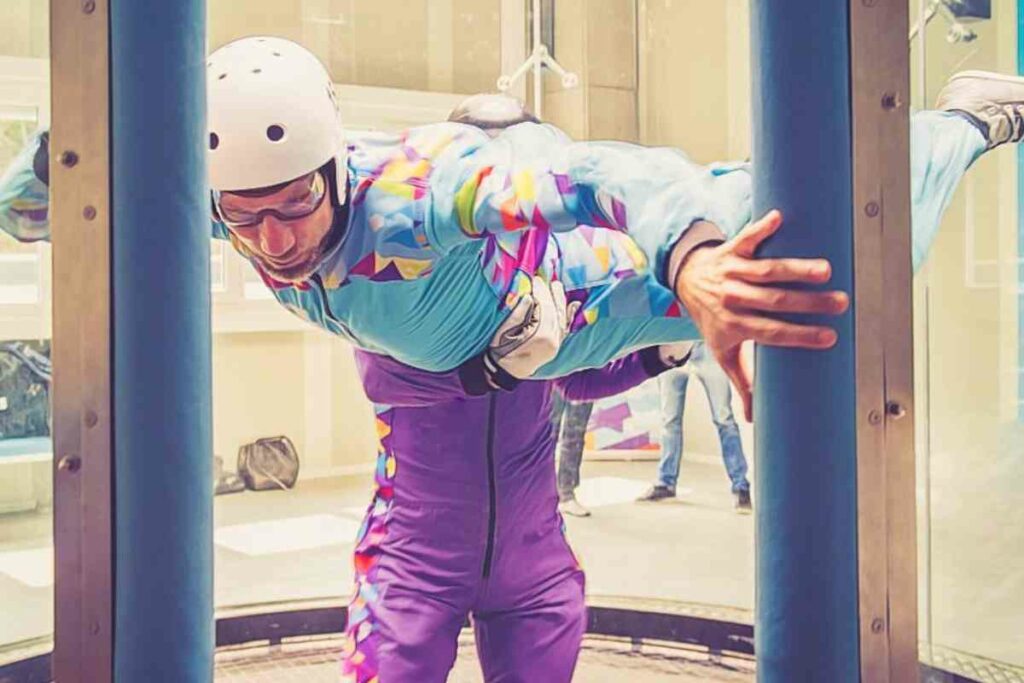Are you looking to experience the thrill of free fall safely? Indoor skydiving allows you to experience weightlessness without the added business of planes and parachutes.
But not everyone is eligible, and weight is essential for indoor skydiving.
Why Choose Indoor Skydiving?
While some may find jumping out of a plane thrilling to experience freefall, skydiving is a nerve-wracking ordeal for most people.
And if you’re not up for the risks involved, you’ll be happy to know that you can still experience freefall only a few feet off the ground.
That’s where indoor skydiving comes in. Indoor skydiving facilities use vertical wind tunnels to simulate the sensation of freefall.
Read before you go – Can You Indoor Skydive If You Have a Medical Condition?
Thanks to powerful fans at the tunnel’s bottom (or top), vertical wind tunnels can create a smooth cushion of air strong enough to float on.
But as fun as it can be, indoor skydiving is not for everyone. Indoor skydiving centers enforce several restrictions to ensure individual safety. What are the restrictions for wind tunnel flights? Do you qualify for this thrilling experience?
Indoor Skydiving Restrictions
Indoor skydiving is often marketed as an inclusive activity in which anyone can participate, but that’s not entirely true.
For instance, weight can be a disqualifying factor when indoor skydiving. You’ll not be allowed to participate if your weight exceeds the set limit.
Weight is critical in indoor skydiving but is not the only consideration.
Here are factors that may affect your eligibility for a thrilling ride in a vertical wind tunnel:
- Age. The age limit for indoor skydiving is 3–103 yrs.
- Height. Weight and height go hand in hand, and your height can impact your weight limit. (see table below)
- Health. Individuals with specific health issues, such as heart problems, cannot participate.
- Physical condition. You can’t participate in indoor skydiving if you have previously dislocated your shoulder or back.
- Pregnancy. You may not be allowed to go indoor skydiving if you are pregnant.
- Drugs and alcohol. People under the influence of alcohol or non-prescription drugs can’t participate in indoor skydiving.
Keep in mind that these restrictions are enforced for your safety. If you want a safe flight, follow all the precautions laid out by your instructor.
How Weight Affects Indoor Skydiving
The surface area of the flyer’s body is one of the factors affecting the amount of lift generated by the wind tunnel.
Heavier people tend to have a larger surface area, meaning the wind tunnel generates more lift to levitate their bodies.
The instructor will adjust the speed of the wind tunnel depending on your weight, but only to a certain limit.
Beyond that limit, the risk of injury during a wind tunnel flight increases significantly.
Weight Limit for Indoor Skydiving
So, what’s the cut-off weight for indoor skydiving? The average weight limit for indoor skydiving in the United States is 250 pounds.
Height is also critical — the taller you are, the more air is required to keep you afloat.
The maximum weight for indoor skydiving varies for women (200 pounds).
The different centers of gravity between men (chest) and women (lower body) impact flight aerodynamics, resulting in different weight limits for indoor skydiving.
Here’s a summary of the weight restrictions based on height in indoor skydiving for men and women.
| Height | Weight in lbs (Women) | Weight in lbs (Men) |
|---|---|---|
| Under 4’5 | 100 | 120 |
| 4’5 – 4’11 | 130 | 150 |
| 5′ – 5’6 | 170 | 190 |
| 5’7 – 6′ | 190 | 230 |
| Over 6′ | 200 | 250 |
But wait, how do they know your weight?
Well, they weigh you — the indoor skydiving team must ask you to step on a scale before your flight.
No one will say your weight out loud, so worrying about being embarrassed is unnecessary.
Can You Still Take A Flight If You Exceed The Cut-Off Weight?
Skill level is also a factor when determining eligibility for indoor skydiving.
The ability to maintain proper body positions and control your movements during the flight reduces the risk of injury in heavier individuals.
Therefore, highly skilled indoor skydivers can still participate even if they exceed the maximum weight limit.
Just call the indoor skydiving center in advance to explain your situation.
Conclusion
You can experience the thrill of freefall without jumping from an airplane at 10,000 feet. Indoor skydiving centers across the country make that possible.
Being informed about all the requirements at an indoor skydiving facility, including weight restrictions, ensures you’re comfortable and excited about your experience.







